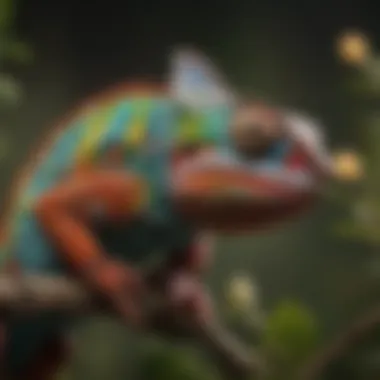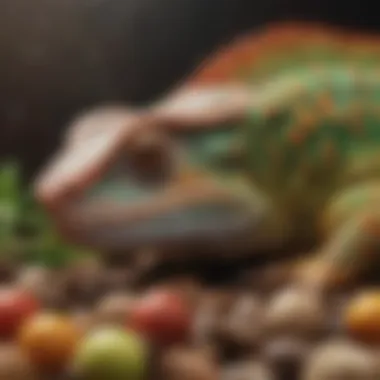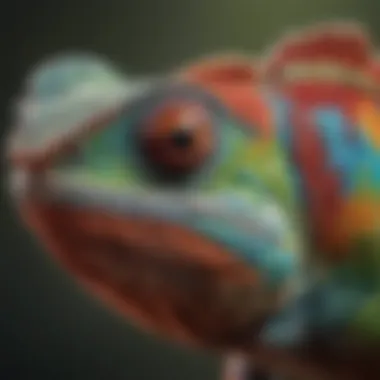Understanding Costs and Care for Panther Chameleons


Intro
When considering adding a Panther Chameleon to your family, it's not just about the charm of their vibrant colors or their captivating eyes. Understanding the financial landscape surrounding these mesmerizing reptiles is crucial for fostering a healthy environment for them at home. From the initial cost to the ongoing expenses, each penny plays a role in ensuring your Panther Chameleon flourishes. This article strives to illuminate what's involved in the ownership journey, helping you navigate the complexities that come with such a unique pet.
Pet Care Essentials
Caring for a Panther Chameleon involves several foundational elements. While they may be low on need for daily interaction compared to dogs or cats, they require a tailored approach to their care.
Daily Nutrition Requirements
Panther Chameleons thrive on a varied diet of insects; crickets, roaches, and silkworms are among the favorites. A balanced diet is non-negotiable. It's best to gut-load these insects with nutritious foods before feeding them to your chameleon. You might also incorporate supplements like calcium and vitamins to ensure your chameleon stays healthy. Expect to budget around $30 to $50 monthly just for food and supplements.
Exercise and Playtime
While Panther Chameleons don’t romp around like a puppy, they do need the opportunity to explore. Setting up branches, vines, and shelves in their habitat encourages climbing and movement. A well-structured vivarium can influence their physical health. Make it a point to observe them regularly to ensure they are active, and allow for supervised out-of-cage exploration when appropriate.
Grooming Tips
Interestingly, chameleons do not require grooming in the traditional sense. However, maintaining a clean habitat is essential. Regularly clean their vivarium—removing uneaten food, waste, and any mold—keeps their environment hygienic and minimizes the risk of health issues. Checking their skin for signs of shedding issues or other anomalies is also a wise move. Being proactive about habitat maintenance can save you significant hassle (and money) down-the-line.
Health and Wellness Check-ins
Routine health check-ups are often overlooked but are integral for your chameleon's well-being. You might not think to take your reptile to the vet as frequently as a dog or cat, but a yearly wellness consultation can help catch any potential concerns early. This might add an additional $50 to $150 annually, depending on your region and the vet’s expertise.
"An ounce of prevention is worth a pound of cure."
Behavior & Training
Understanding your chameleon's behavior can enhance your relationship and aid in their care. They communicate their state of mind through body language, and being attuned to these signals can prevent stress.
Understanding Your Pet's Body Language
Chameleons exhibit a range of colors when they're happy, stressed, or upset. A chameleon displaying bright colors is usually in a good mood, whereas dark or dull colors might suggest stress. Paying attention to these shifts can inform how you approach their care.
Basic Training Techniques
While training a chameleon might sound unconventional compared to training a dog, it's not impossible. Offering treats when they come out of hiding or when they explore their habitat can condition them to associate positive experiences with certain actions. It's a simple principle: they learn that exploration often leads to tasty rewards.
Behavioral Concerns & Solutions
If your chameleon is excessively hiding, it may indicate stress or discomfort in their environment. Addressing this involves examining their habitat for any potential stressors like loud noises or insufficient humidity. Adjusting their environment can lead to noticeable improvements in their behavior.
Socialization Tips
While Panther Chameleons are naturally solitary creatures, gentle handling can help them acclimate to human interaction. When introducing your chameleon to light handling, it’s critical to be calm and patient. Gradually allow them to get comfortable with your presence, as this can build a level of trust.
Pet Home Environment
Creating a suitable home for your Panther Chameleon is arguably one of the most important aspects of ownership. The environment dramatically influences their health and behavior.
Creating a Pet-friendly Space
A proper enclosure is a must. Generating a vertical space with plants, branches, and hiding spots allows your chameleon to feel secure while mimicking their natural habitat. Consider a minimum enclosure size of 2 feet wide by 2 feet deep and 4 feet tall, depending on the age of your chameleon.
Safety Measures and Hazards to Avoid
Ensure the habitat is free from drafts or direct sunlight, which can lead to overheating. Using appropriate materials is also vital—avoid cedar and pine, as these woods can be toxic to reptiles. Providing proper ventilation is equally essential to replicate their native tropical environment.
Choosing the Right Toys and Accessories
While chameleons don't play with toys in the traditional sense, they do appreciate naturalistic elements like branches and foliage to climb. Plants should be non-toxic and safe for chameleons, such as pothos or hibiscus. Having a variety of textures in their space keeps them engaged.
Setting Up a Comfortable Resting Area
A designated spot for your chameleon to rest should be included in their setup—a higher branch or perch in a shady area can be their preferred chill zone. Balance is key. Too many open spaces can stress them out, while too many cover spots might deter movement and exploration.
Pet Health Issues
Monitoring the health of your Panther Chameleon requires vigilance. Recognizing signs of illness early can make all the difference in their recovery.
Recognizing Signs of Illness
Sitting at the bottom of their habitat, lack of appetite, or discoloration of skin are red flags. Regular observation can help you catch these signs early. If something seems off, it’s prudent to consult a vet experienced with reptiles.
Preventative Care Measures
Prevention includes maintaining proper hydration levels, managing temperature gradients, and ensuring a well-balanced diet. Keeping a close eye on your vermin also goes a long way—ensuring they are healthy is just as vital as your chameleon's health.


Common Ailments and Treatments
Infections and parasites are common issues in chameleons. Treatment options generally involve medication prescribed by a vet. Knowing the common risks can prepare you to act quickly if issues arise.
Emergency Preparedness
Having a plan in place for emergencies ensures you’re ready for anything. Keep vet contact information handy, and be familiar with the nearest emergency animal hospital. This precaution can save valuable time during a crisis and ultimately impact your chameleon's recovery.
Ensuring proper care for a Panther Chameleon can be both fulfilling and challenging. Understanding the costs involved and the responsibilities can lead to a rewarding experience for both you and your future companion.
Prologue to Panther Chameleons
Panther Chameleons are not just any typical reptiles; they are vibrant, captivating creatures that offer a unique glimpse into the complexity of nature. Understanding them serves as a foundational aspect for anyone considering taking one of these remarkable pets under their wing. This section will delve into defining the Panther Chameleon, exploring its natural habitat, and deciphering its behavioral characteristics—all of which are essential for future owners to appreciate.
Defining the Panther Chameleon
Panther Chameleons, scientifically known as Furcifer pardalis, are native to Madagascar and the nearby Comoros Islands. They are particularly known for their stunning coloration and the ability to change their hue in reaction to environmental stimuli, such as temperature and social interactions. Adult males flaunt vibrant shades of blue, green, and orange, while females are typically less colorful, donning earthy tones that blend seamlessly into their surroundings.
These reptiles grow to an average length of about 3 feet, depending on their age and genetics, making them relatively large compared to other chameleon species. Their distinctive physical features—a laterally flattened body, a long curled tail, and large, bulging eyes that can move independently—contribute to their charm and appeal. Understanding these defining characteristics is crucial for anyone looking to assess whether a Panther Chameleon fits their lifestyle and preferences.
Natural Habitat
The natural habitat of Panther Chameleons varies significantly within Madagascar. They prefer humid, dense forests where trees offer plenty of cover as well as places to bask in the sun. Living primarily in the tree canopy, they are arboreal creatures that rely on their climbing abilities for both hunting and evasion. If you want to replicate this habitat at home, it’s vital to think about factors like humidity, temperature, and adequate space for climbing and hiding.
Surprisingly, despite being popular in the pet trade, their natural habitat is rapidly diminishing, leading to increased concerns about their conservation status. A profound respect for their natural origins and understanding their habitat requirements can guide responsible ownership.
Behavioral Characteristics
Panther Chameleons display a range of intriguing behaviors, with much of their activity centered around their territorial nature. Males are particularly known to be aggressive, often engaging in displays such as head bobbing and color changes to assert dominance. Female chameleons, on the other hand, are more subdued and exhibit less territorial aggression.
These remarkable reptiles also communicate through body language, with their colors serving as a signal to other chameleons regarding mood and intent. Sometimes aggressive displays can lead to actual confrontations, making it crucial to monitor their interactions, especially in a communal setup.
Moreover, they are diurnal, meaning they are most active during the day, spending time basking under the sun and hunting insects. Their diet mainly consists of various insects such as crickets, roaches, and flies, supplemented by the occasional fruit in captivity. Thus, understanding these behavioral aspects is key to ensuring they thrive in home environments.
"Every interaction with your Panther Chameleon is one more opportunity to understand them better, ultimately leading to a richer owning experience."
In summary, the introduction to Panther Chameleons lays down a comprehensive foundation for the subsequent sections about their costs and care requirements. By appreciating their defining traits, natural environments, and behavioral quirks, prospective owners can make informed decisions that not only enrich their lives but also ensure the well-being of their chameleons.
Initial Purchase Cost
Understanding the initial purchase cost of a Panther Chameleon is vital for anyone contemplating bringing one into their life. The reality is that this figure isn't just a number; it encompasses multiple elements that affect long-term financial commitments and preparation for the responsibility of owning such a unique pet. A well-informed owner can better navigate the often fluctuating costs associated with chameleons, ensuring they provide optimal care for their new companion.
Where to Buy
When it comes to acquiring a Panther Chameleon, potential buyers have several avenues. Local pet shops, reptile expos, and authorized breeders are common sources. However, each option carries its own advantages and disadvantages.
Purchasing from a reputable breeder generally ensures higher standards of care and health for the chameleons, often leading to price variations that reflect this commitment. It's crucial to ask questions and do preliminary research about the source. Buying from chains or unverified sellers might save a few bucks, but the long-term value could be severely undermined if the chameleon isn't properly cared for prior to sale.
Factors Affecting Price
When scrutinizing the costs involved in acquiring a Panther Chameleon, it’s imperative to understand the intricate factors contributing to the price.
Breeder Reputation
Breeder reputation can significantly impact the overall cost of purchasing a Panther Chameleon. Reputable breeders tend to invest considerable effort into breeding healthy and vibrant chameleons, and this commitment can translate into higher prices. These breeders typically implement better breeding practices and care standards, cultivating animals that are more likely to thrive in captivity.
The distinguishing feature of a reputable breeder is often their focus on genetic diversity and health checks. This is particularly beneficial for potential owners, as it can reduce the possibility of health issues down the line. However, the downside is that high-quality breeders often have waiting lists or limited availability, which some may find inconvenient.
Color Morphs
The variety of color morphs available in Panther Chameleons is another aspect that can influence the purchase price. Color morphs refer to the unique color variations that these chameleons exhibit, and certain morphs can be exceedingly rare, causing their price to skyrocket. For instance, some vibrant morphs like the Ambilobe or Nosy Be can demand a premium due to their striking appearance.
This diversity allows owners to select a chameleon that truly reflects their personal aesthetics. However, prospective buyers should consider the unique investment involved—beyond appearance, the rarity of certain morphs can sometimes lead to unexpected health challenges. This is something to keep in mind when making a purchase.
Age and Size
The age and size of a Panther Chameleon can also play a role in its market price. Younger chameleons might come at a lower price point, but they require more care and time to reach maturity. On the contrary, larger, more established chameleons may be costlier, but they can often provide a more stable starting point for new owners, already acclimatized to captivity.
New owners should take into account the trade-off between immediate expense and the overall investment in care and growth. Larger individuals may already exhibit health and behavioral stability, which is positive. But again, with size usually comes a greater cost, requiring careful budgeting.
Typical Price Range
Typically, the purchase price of a Panther Chameleon can vary greatly based on the factors discussed above. Generally, new owners might expect to spend anywhere from $100 to $400. This range reflects not only the qualities of the chameleon itself but also the breeder, location, and specific traits sought after by potential owners.
In summary, understanding the initial purchase cost is a multifaceted journey involving many considerations. From selecting the right source, factoring in unique characteristics, and budgeting for variations in size and age, this knowledge equips potential owners for achieving the best possible experience with their Panther Chameleons.
Setup Costs


Setup costs are an essential part of owning a Panther Chameleon, as these figures can stack up quickly if one isn't careful. This section will unravel the numerous components needed to create a comfortable habitat for these unique creatures. Each piece of the setup contributes to a thriving environment, which is vital for both health and contentment of the chameleon. With the right setup, you can keep your chameleon happy and vibrant, which ultimately enhances the experience of ownership.
Enclosure Requirements
Size Considerations
The size of the enclosure plays a pivotal role in ensuring your chameleon's well-being. In essence, a larger space allows for better air circulation and provides chameleons with ample room to explore and climb, mimicking their natural environment. Many film of new owners underestimating just how much space their pet needs. A minimum requirement for an adult Panther Chameleon’s cage is typically around 24 inches wide, 24 inches deep, and 48 inches tall.
Think of it this way - a cramped space can lead to increased stress levels in the chameleon, resulting in a less lively pet. Conversely, a spacious environment allows for physical activity which is fundamental for their health. Plus, providing various branches and plants can encourage climbing behavior, something that Panther Chameleons naturally do.
Materials Used
Choosing the right materials for enclosures can make a significant difference in both maintenance and comfort for your chameleon. Commonly, reptile glass terrariums are favored due to their durability and visibility. Screen enclosures are another popular choice because they offer great airflow while keeping the humidity levels stable.
An important aspect here is to avoid materials that might not be safe for your chameleon. For example, woods treated with chemicals can be harmful. Instead, opting for untreated plywood or specific reptile-safe materials is the way to go.
This thoughtful selection of materials not only enhances the aesthetic aspect of your setup but ensures a healthier environment for your pet. However, do consider that maintaining proper humidity and temperature will be essential, depending on the materials chosen.
Lighting and Heating
Proper lighting and heating are crucial for your chameleon’s health. They require specific UVB lighting to metabolize calcium, and without it, they can develop metabolic bone disease. Furthermore, the correct temperature gradients are necessary for providing a basking area and a cooler side in the enclosure. It’s also vital to have the right sun cycle, too long or too little can confuse their circadian rhythms. This will involve an additional expense, but it’s something to factor into the budget right off the bat.
Decor and Accessories
Live Plants
Incorporating live plants into the chameleon’s habitat not only improves the aesthetic appeal but also serves as a natural hiding spot and climbing surface. Certain types of plants like Pothos or Ficus are particularly popular and relatively low maintenance. They provide the necessary humidity and make the enclosure feel more organic.
Having live plants means they can mimic their natural environment more closely. On the flip side, you'll need to ensure that these plants are safe for your chameleon and free of pesticides. This might require more research and effort, but the benefits for your pet are well worth it.
Hiding Spots
Creating hiding spots in the enclosure can help reduce stress levels in your chameleon, as they often like places to retreat to when they feel threatened. Various commercial hides are available, but you can also use cardboard boxes or even hollow logs.
A well-planned arrangement can lead your chameleon to feel secure and less prone to displaying signs of anxiety. This is critical because a relaxed chameleon is likely to be healthier and more vibrant. By factoring in their psychological well-being, you prioritize your pet’s overall health, making the additional costs worthwhile.
Ongoing Care Costs
When considering the expenses of owning a Panther Chameleon, ongoing care costs play a monumental role. These are not merely one-time purchases but continuous outlays that ensure your pet's health and happiness throughout its life. From food to veterinary visits, these recurring expenses can add up, making it crucial for prospective owners to understand what they entail.
Food Expenses
Insects
Feeding a Panther Chameleon primarily involves providing a diet rich in insects. These creatures are a staple in their diet, offering essential nutrients that help maintain their vitality. Crickets, roaches, and mealworms are among the most popular choices. One key charactristic of these insects is their protein content, vital for growth and immune function.
Each type of insect has its unique benefits and considerations:
- Availability: Crickets are widely accessible and quite easy to buy online or at local pet stores.
- Cost-Effective: They often present a lower purchase cost compared to specialty insects.
However, it’s worth noting that insects also come with challenges. For instance, ensuring they are gut-loaded and nutritionally rich is vital for the health of your chameleon. If you opt for insects, make sure to check where to source them comprehensively; sometimes local sellers may provide better nutrition than the standard supermarket.
Supplementation
Alongside insects, supplementation is paramount to a balanced diet. This involves adding vitamins and calcium to their food. A popular choice is calcium powder, which helps fortify their bones and aids in proper development. The unique feature about calcium supplementation is its ease of use; you can simply dust the insects before feeding them to your chameleon.
Moreover, vitamin D3 is essential and often included in reptile-specific supplements. It allows for better calcium absorption, which is crucial for chameleons because they are prone to metabolic bone disease if their diets are lacking.
However, one must tread carefully to avoid over-supplementation, as it can lead to toxicities. Observing the chameleon's health post-supplementation can help gauge whether adjustments are necessary.
Veterinary Care
Routine Check-ups
Regular veterinary visits are another essential aspect of ongoing care. Routine check-ups help catch potential health issues early. One significant advantage of these visits is that they provide peace of mind for the owner.
A veterinary exam typically includes:
- Physical assessments.
- Checking for parasites.
- Discussing diet and habitat.
This proactive approach can prevent expensive treatments down the line. Establishing a trusting relationship with a vet who specializes in reptiles can also be invaluable. Remember that not all vets are versed in exotic animals, so this can make all the difference.
Emergency Care
Despite all preventive measures, emergencies can arise. From respiratory illnesses to accidental injuries, having access to emergency care is pivotal. It’s a costly but necessary consideration, knowing that a sudden vet bill could hit hard.
An emergency vet visit can sometimes run from hundreds to thousands of dollars, largely depending on the issue at hand and complexity involved in treatment. However, the unique feature of an emergency vet is that they can prove lifesaving. So, having a financial plan in place to accommodate these unexpected expenses is essential for responsible ownership.


Maintenance Costs
Cleaning Supplies
Maintaining a clean habitat is critical for your Panther Chameleon’s health. Regular cleaning prevents the buildup of bacteria and parasites that can harm your pet. The primary cleaning supplies you might need include:
- Disinfectants specifically designed for reptile habitats.
- Substrate replacements when necessary (e.g., paper towels, coconut fiber).
Investing in quality cleaning supplies ensures a long-lasting and effective cleaning process, allowing for a healthy living environment.
Replacement Materials
As time passes, components of the chameleon's habitat will need replacing. This can include:
- Broken branches or decor.
- Worn-out substrates.
Being prepared to replace these items is crucial for ongoing care. They maintain the necessary environment for your chameleon’s comfort and security. Failing to replace or adequately maintain habitat elements could lead to stress or health issues, so plan for these potential costs accordingly.
By acknowledging these ongoing care costs and understanding their significance, current and future owners can ensure their Panther Chameleons enjoy a healthy and fulfilling life. A careful approach to budgeting for these needs will not only benefit your chameleon but will also create a more seamless ownership experience.
Long-Term Financial Commitment
Considering a Panther Chameleon as a pet is not just about the initial excitement of bringing one home. The long-term financial commitment is a significant aspect that every potential owner must take to heart. Caring for a chameleon encompasses much more than just purchase costs; it involves a series of ongoing and sometimes unexpected expenses that can add up over the lifespan of these fascinating creatures.
Understanding Lifespan
First things first, let’s talk about lifespan. A well-cared-for Panther Chameleon can live anywhere from five to eight years, sometimes even longer with proper care. This longevity means that when you decide to adopt one, you're essentially taking on a commitment that might last for nearly a decade. Considerations should include not just regular food, but also adequate space, lighting, and health care throughout this time.
The lifespan can vary based on several factors, including:
- Diet: A balanced diet rich in vitamins and minerals can greatly influence a chameleon's health over time.
- Living conditions: An enclosure that meets their needs for space and humidity, along with proper temperature gradients is crucial.
- Veterinary care: Regular check-ups and prompt treatment for any health problems will extend their life and improve quality.
Recognizing these factors can make a world of difference in how you plan your finances.
Budgeting for the Future
Next on the list is budgeting for the future. It’s wise to recognize that expenses will rise and fall at different stages of your chameleon’s life. Starting off, the costs might feel manageable, but as your chameleon ages, you may face higher vet bills or the need for more specialized equipment. Here are some aspects to keep in mind when budgeting:
- Set aside a monthly budget: Allocate funds every month to prepare for expected and unexpected expenses. It doesn’t hurt to have a separate savings account dedicated to chameleon care.
- (Veterinary expenses): Routine check-ups should be a priority. An emergency fund is also essential, as unexpected health issues can strike at any moment.
- Supplies and maintenance: Consider the cost of maintaining the habitat. Replacement bulbs for lighting, cleaning supplies, or changes in decor should not come as a shock. Think about how often you might need to update these items.
Lastly, it's crucial to stay informed about the trends in care and the potential advances in chameleon husbandry. Joining communities on platforms like Reddit can connect you with other owners who share their financial experiences and provide valuable insights.
"Owning a chameleon isn’t only about passion; it’s a financial commitment that requires foresight."
Health and Well-being
The health and well-being of a Panther Chameleon is paramount for those considering adding one of these colorful creatures to their lives. Understanding how to assess their condition and respond to any health issues is crucial. Just as humans need regular check-ups and a stable environment, so do these fascinating reptiles. Ignoring their health can lead to complications that not only affect their lifespan but also may result in hefty veterinary bills. A healthy chameleon exhibits vibrant colors and active behaviors, which is a satisfying sight for any owner.
Signs of a Healthy Chameleon
Recognizing when a panther chameleon is in good health is an essential skill for owners. Physical appearance and behavior are the primary indicators. Here are a few signs to keep an eye out for:
- Vibrant Color Returns: A healthy chameleon will display bright and vivid colors, which can change based on mood and environment. If your chameleon seems dull or faded, it might not be feeling its best.
- Active Behavior: An energetic chameleon often means a happy and healthy one. If it spends time basking but is otherwise lethargic, that’s cause to raise an eyebrow.
- Clear Eyes: The eyes should be clear and bright. Cloudiness can indicate illness or dehydration, while bulging eyes might signal respiratory issues.
- Good Appetite: Healthy chameleons generally have a strong appetite for insects. If your chameleon refuses food for more than a day or two, keep an eye on it.
A healthy chameleon has a keen sense of its surroundings, often observing and interacting with its environment.
Addressing Common Health Issues
Being aware of common health issues can mean the difference between life and death for a panther chameleon. Here are several conditions that are often encountered:
- Metabolic Bone Disease (MBD): This affects many chameleons due to improper calcium intake and UV light exposure. Symptoms include swollen limbs and difficulties moving. It’s essential to provide proper supplementation and UV lighting to prevent MBD.
- Respiratory Infections: Dull colors, lethargy, and lack of appetite can signal a respiratory infection. Humidity levels should be monitored closely; too high or too low can lead to problems.
- Dehydration: Chameleons require moisture, primarily through their food and drinking water. Signs include lethargy and sunken eyes. Regular misting and providing a water source are key in ensuring hydration.
- Parasites: Intestinal parasites can lead to weight loss and diarrhea. Regular veterinary check-ups can help assess for any issues.
Timely intervention can often catch these issues before they escalate. Regular veterinary visits, a balanced diet, and proper habitat setup create a healthy environment conducive to thriving.
Culmination
Summary of Costs and Care
Understanding the costs associated with owning a Panther Chameleon is not merely about crunching numbers; it is about grasping the full picture of what it takes to ensure the well-being of these unique creatures. Initial costs can be steep, ranging from the chameleon’s price to the setup for their habitat. The ongoing expenses, like food, veterinary care, and maintenance, can add up as well. For instance, you may find yourself budgeting for quality feeder insects, and even specialized supplements to keep your chameleon in top shape. These considerations can guide your financial planning and help prevent unpleasant surprises down the road.
Here’s a rundown of costs owners might expect to encounter:
- Initial Purchase: Generally varies based on factors like color morphs and breeder reputation.
- Setup Costs: Includes the enclosure, lighting, heating, and decor. A well-prepared habitat could set you back significantly.
- Ongoing care: Food costs adust with seasons, and veterinary expenses also contribute to long-term budgeting. Routine check-ups are absolutely necessary to catch potential health issues before they become serious problems.
Overall, these figures are important, but they aren’t the only thing to consider.
Final Thoughts on Ownership
Owning a Panther Chameleon can be incredibly rewarding, yet it demands commitment and responsibility. The joy of watching these captivating reptiles thrive in your care is unmatched. However, with that joy comes a significant responsibility. Understanding their specific needs is crucial: a diverse and balanced diet, a well-designed habitat, and access to veterinary care.
Moreover, the long-term financial commitment becomes clear once you consider the lifespan of these chameleons, which can range from six to eight years, or even longer with proper care. This makes it all the more important to think ahead and consider any changes in your life that might affect your ability to care for a pet.
"The bond between a chameleon and its owner is one of mutual understanding; when care is given, happiness blossoms."
In sum, assess your readiness before diving into ownership. Consider expenses carefully, and above all, cherish the unique journey that comes with keeping a Panther Chameleon as a pet.







